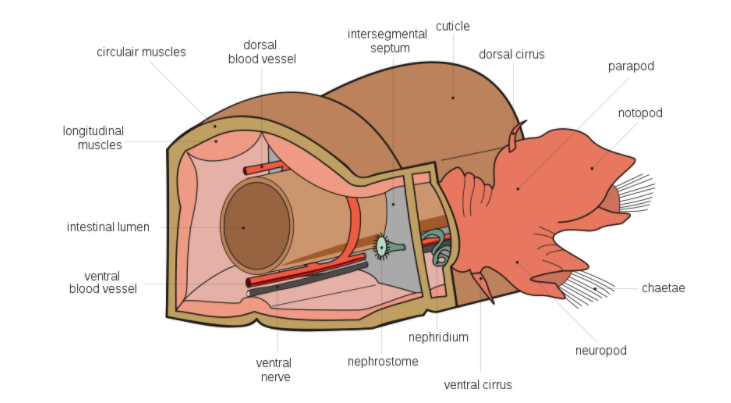
Septal nephridia of earthworm are-
A. Responsible for excretion
B. Present in all body segments
C. Responsible for keeping the surface moist
D. Present in
Answer
483.3k+ views
Hint: Belonging to Opisthopora order, the earthworm is an invertebrate. The body of earthworm is segmented and each contains and protects different types of organs that perform various processes in its body. The circulatory system, muscular system, digestive, nervous, excretory and nervous systems are the types of organic systems that are present in an earthworm.
Complete answer:
-Nephridia are like kidney invertebrates. They are always found in pairs. They help in removing the metabolic wastes from an animal’s body. Septal nephridia are responsible for the excretion in Earthworms.
-These are situated on the inter-segmental septum in between them,
-Each of the septa contains about
-Each segment exhibits
-Each septum posse’s nephridia on both the surfaces and they are present in semi circles around its intestine, two of the rows are in front of the septum and two are behind it.
-They are not found in the segments up to
-It is considered typical of all the nephridia of Pheretima.
-Each of the septal nephridia consists of the body of nephridium, nephrostome, neck, and terminal duct.
-Nephridia hang freely in the coelom and they are attached only with the help of their terminal ducts.
-They open by the terminal ducts into two septal excretory canals which lie on the posterior surface of the septum; one is present on each side of the intestine, beginning ventrally but dorsally opens in the supra-intestinal excretory duct.
Waste collected by the nephridia is directed outside through the excretory canals and ducts into the intestine's lumen.
-These types of nephridia that open into the intestine are known as Enteronephric nephridia.

Hence, the correct answer is option (A).
Note: The earthworm is made of around
Complete answer:
-Nephridia are like kidney invertebrates. They are always found in pairs. They help in removing the metabolic wastes from an animal’s body. Septal nephridia are responsible for the excretion in Earthworms.
-These are situated on the inter-segmental septum in between them,
-Each of the septa contains about
-Each segment exhibits
-Each septum posse’s nephridia on both the surfaces and they are present in semi circles around its intestine, two of the rows are in front of the septum and two are behind it.
-They are not found in the segments up to
-It is considered typical of all the nephridia of Pheretima.
-Each of the septal nephridia consists of the body of nephridium, nephrostome, neck, and terminal duct.
-Nephridia hang freely in the coelom and they are attached only with the help of their terminal ducts.
-They open by the terminal ducts into two septal excretory canals which lie on the posterior surface of the septum; one is present on each side of the intestine, beginning ventrally but dorsally opens in the supra-intestinal excretory duct.
Waste collected by the nephridia is directed outside through the excretory canals and ducts into the intestine's lumen.
-These types of nephridia that open into the intestine are known as Enteronephric nephridia.

Hence, the correct answer is option (A).
Note: The earthworm is made of around
Recently Updated Pages
Master Class 11 Economics: Engaging Questions & Answers for Success

Master Class 11 Business Studies: Engaging Questions & Answers for Success

Master Class 11 Accountancy: Engaging Questions & Answers for Success

Master Class 11 English: Engaging Questions & Answers for Success

Master Class 11 Computer Science: Engaging Questions & Answers for Success

Master Class 11 Maths: Engaging Questions & Answers for Success

Trending doubts
Which one is a true fish A Jellyfish B Starfish C Dogfish class 11 biology CBSE

State and prove Bernoullis theorem class 11 physics CBSE

1 ton equals to A 100 kg B 1000 kg C 10 kg D 10000 class 11 physics CBSE

In which part of the body the blood is purified oxygenation class 11 biology CBSE

One Metric ton is equal to kg A 10000 B 1000 C 100 class 11 physics CBSE

Difference Between Prokaryotic Cells and Eukaryotic Cells




